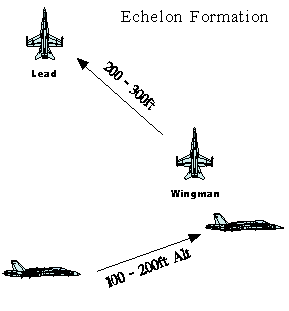Formations
During W.W.I, when air battles were in their infancy, not much attention was paid to the actual formation of the flight. Most of the time, aircraft were lined up like marching solders and sent off to battle. By the end of the war though, the U.S. and other countries adopted the "V" or Vic formation as the standard flight pattern. During the Spanish Civil War, the Germans were using Spain as a tactics and stratagy training ground. From this, several new tactics were formed surrounding the use of fighter formations. The Germans created the "Rotte" formation where 2 ships hung loosely from each other in sort of an exagerated echelon formation. This allowed the German pilots a greater field of view to spot aircraft planform. It also kept attackers from sneaking up on the formation. The British and Americans adopted a form of this formation called the "finger four".
Today, there are several formation patterns used separately by the Air Force, Navy, and even the Army. The best formation patterns for the FA-18 Hornet arena are the Echelon Formation or the Combat Spread. The Echelon Formation places the wingman behind and staggered to the right or left of the wingleader. The wingman is also at a slightly lower altitude. Distance is usually 200 to 300 ft seperation

The Combat Spead formation puts the wingman flying abeam or beside the wingleader at a slightly lower altitude. This is also called Line-Abreast Formation. Distance again is usually 2000 to 3000 ft seperation. The purpose of the lower altitude is to give the wingleader room to maneuver in case of a needed quick break turn or such.
